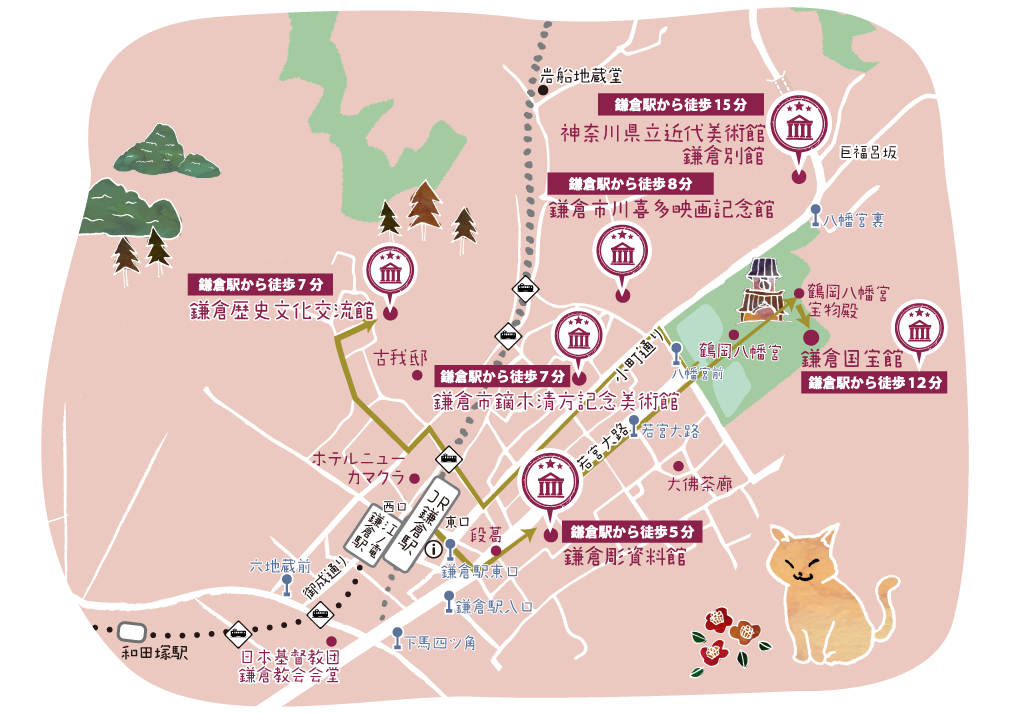
Cultural treasure rambles
Traditional paintings and handicrafts (Kamakura Station area)

- Kamakura Station
- 5 minutes-walk
- Kamakurabori Museum
- 8 minutes-walk
- The Treasure Hall at Tsurugaoka Hachimangu Shrine
- 1 minutes-walk
- Kamakura Kokuhoukan Museum
- 17 minutes-walk
- Kamakura Museum of History and Culture
- 8 minutes-walk
- Kamakura Station
 Kamakura Station Start
Kamakura Station Start
There are museums near Kamakura Station, where you can experience traditional Kamakura and enjoy a taste of Kamakura’s traditional culture.
 Curator's recommends
Curator's recommends

Komachi
Look, it’s a Kamakurabori carving shaped like a bird! It’s really cute.
Look, it’s a Kamakurabori carving shaped like a bird! It’s really cute.
Tamura Sari, Curator at Kamakurabori Museum
It’s really adorable, isn’t it? This chubby and perfectly round small waterfowl looks like it is floating on water. It is actually a tea ceremony utensil, a small container for keeping incense. It was made in the Edo period, when the tea ceremony was popular and all sorts of Kamakurabori tea utensils were produced.


Shirasu
It has turned black in places, hasn’t it?
It has turned black in places, hasn’t it?
Tamura Sari, Curator at Kamakurabori Museum
Yes, you can see the black lacquer that was used for the ground. You can see how the depth of the texture has evolved with the years.


Komachi
The patterns carved into it are charming.
The patterns carved into it are charming.
 8minutes-walk
8minutes-walk
Treasures Protected by Hachiman, the God of War
Since the Kamakura period, national treasures, important cultural properties, and many other sacred treasures have been kept at Tsurugaoka Hachimangu Shrine where samurai once worshipped. In 1902, the north side of the main shrine was rebuilt to house a permanent gallery for the treasures. During the war, the national treasures were evacuated, and the building was temporarily closed. It reopened after the war, in 1947.
 1minutes-walk
1minutes-walk
 Curator's recommends
Curator's recommends

Komachi
Let’s go look at the paintings at the Kamakura Kokuhoukan!
Let’s go look at the paintings at the Kamakura Kokuhoukan!
Kaneko Tomoya, Curator, Kamakura Kokuhoukan Museum
Hello. My name is Kaneko Tomoya and I am a curator at Kamakura Kokuhoukan Museum.
Let me tell you about this picture of Ling Zhao from the museum collection.
Let me tell you about this picture of Ling Zhao from the museum collection.


Shirasu
The clothes worn by the girl in the painting are rather different from the Japanese kimono.
The clothes worn by the girl in the painting are rather different from the Japanese kimono.
Kaneko Tomoya, Curator, Kamakura Kokuhoukan Museum
Kaneko Tomoya, Curator, Kamakura Kokuhoukan Museum
Ling Zhao was a girl who lived during the Tang dynasty in China. She was a devout follower of Buddhism from a young age and achieved enlightenment. The story of how she supported her parents by weaving and selling bamboo baskets is a favorite motif at Zen temples. Here, she is depicted slightly turned to the left, a basket on her left arm and some coins in her hands.
The sensitive brush strokes have captured the dedicated expression on her face. Among extant paintings of Ling Zhao, this one is considered a masterpiece.
Ling Zhao was a girl who lived during the Tang dynasty in China. She was a devout follower of Buddhism from a young age and achieved enlightenment. The story of how she supported her parents by weaving and selling bamboo baskets is a favorite motif at Zen temples. Here, she is depicted slightly turned to the left, a basket on her left arm and some coins in her hands.
The sensitive brush strokes have captured the dedicated expression on her face. Among extant paintings of Ling Zhao, this one is considered a masterpiece.


Komachi
She is the ideal image of a dutiful daughter, isn’t she?
She is the ideal image of a dutiful daughter, isn’t she?
 17minutes-walk
17minutes-walk
 Curator's recommends
Curator's recommends

Shirasu
Kamakura is where the shogunate originated. Aren’t there still ongoing excavations here and there in the city?
Kamakura is where the shogunate originated. Aren’t there still ongoing excavations here and there in the city?
Takahashi Shinsaku, Assistant Director, Kamakura Museum of History and Culture
There are excavations underway all the time. There are many historic relics still hidden underground in Kamakura. These artifacts tell the true story of life in medieval Kamakura, providing details not found in the written records. We have a room where we display the archeological artifacts from the Kamakura period when Minamoto no Yoritomo became the first shogun. We plan exhibitions as needed, but we also organize quick exhibitions where we present our latest finds.


Komachi
They give us a sense of everyday reality during that period.
They give us a sense of everyday reality during that period.
 8minutes-walk
8minutes-walk
Search by themes
Search by areas
- Kita-Kamakura Station area
- Kamakura Station area
- Yuigahama Station area
- Hase Station area
- Gokurakuji Station area










